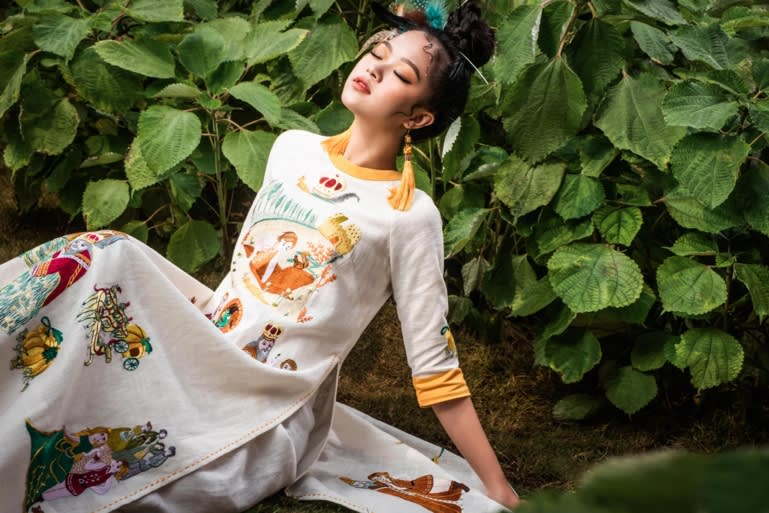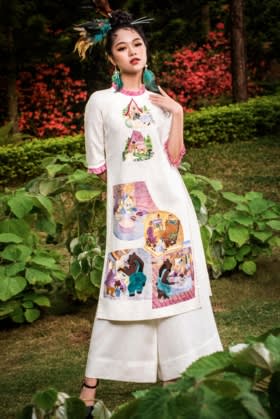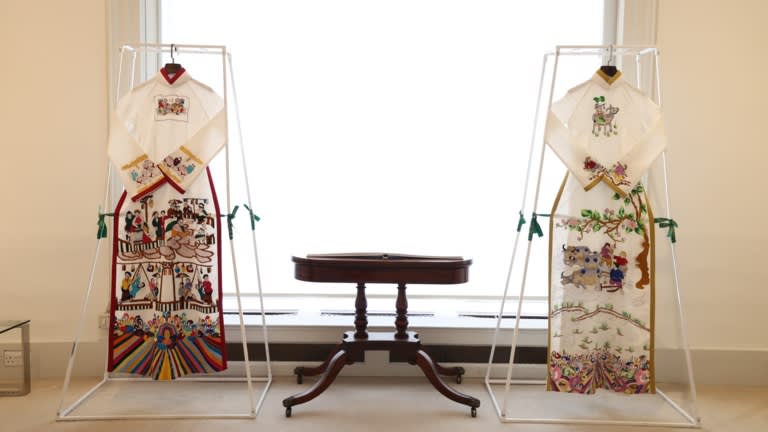Viet
ELITE MEMBER

- Joined
- Jun 18, 2012
- Messages
- 29,950
- Reaction score
- 0
- Country
- Location
Lan Huong makes international splash with sustainability as central goal
Models show off Lan Huong's modern twist on Vietnamese fashion in London's swanky Mayfair district. (Photo courtesy of the Embassy of Vietnam in London)
ZOE FRECHIN-POLLARD, Nikkei staff writerAugust 5, 2023 17:51 JST
LONDON -- Sipping coffee in a London cafe, Vietnamese fashion designer Lan Huong has her family in tow.
Her teenage daughter, Mia Tran, acts as her translator. A grandson, who is not yet 2, wears a beautiful hand-embroidered ao dai, a traditional Vietnamese dress, from Huong's latest collection, "Thriving Planet."
Huong has just held a fashion show at the Vietnamese Embassy to commemorate 50 years of formal relations between her nation and the U.K. Over the last decade, Huong has become an unofficial ambassador for Vietnam, with her creations appearing across the world, from Thailand to the U.S., France and Italy.
Ranging in price from $2,000 to tens of thousands of dollars, her designs have been worn by high-profile women such as former South Korean President Park Geun-hye and U.S. first lady Jill Biden.
More-formal international recognition is starting to follow. Huong was named best designer at the Thai Silk International Fashion Week in Bangkok last December, where the judging panel included the renowned U.K.-based designer Jimmy Choo.
"He told me that he could see my passion and enthusiasm through my work. That was my proudest moment. But I didn't need a prize," says Huong, insisting that the most important aspect of the competition was the opportunity it gave her to push for a green revolution in the international fashion industry.
Fashion is notoriously damaging to the global environment, with the industry accounting for around 10% of global carbon dioxide emissions, according to the United Nations. "For me, the green revolution is about refocusing our love and attention," she says.

Huong grew up in Hoa Binh, a mountainous province in northwest Vietnam, during the period of reconstruction following the country's reunification in 1976. Many years of war had taken millions of lives, as well as destroying livelihoods, homes and infrastructure. As a result, says Huong, she grew up with a strong sense that those around her had lost touch with the natural world.

This cropped gown and trouser creation by Huong features scenes from the tale of Goldilocks. (Photo courtesy of Cuon Ratio Team)
For her new collection, Huong has been working with textiles derived from ramie, a material that has a similar appearance to linen but is often compared to silk for its softness. The crop has a history of cultivation in East Asia spanning thousands of years. Unlike hemp, an eco-friendly rival, ramie can be legally grown in Vietnam, and its leaves are used in traditional black rice cakes.
Amid growing demand for more sustainable approaches in the fashion industry, ramie stands out as a material with great potential for what Huong calls "green circularity."
"Not only is it strong, comfortable and good for humidity, but it is biodegradable, creating a circle of green fashion," she says. The plant can grow on sloped land, and the leaves make good fertilizer. Additionally, the crop can be harvested many times a year and is productive for 10 years before requiring replanting.
Huong is not alone in perceiving the wider societal benefits for Vietnam in promoting ramie. Since 2017, Australia's government has been providing aid in the Son La and Lao Cai provinces of northwest Vietnam, developing ramie plantation areas and providing training and tools to help farmers get started.

With ramie fetching a higher price than rice or corn, it is hoped that the project will financially benefit a multitude of local ethnic minority groups, such as the Hmong, Tay and Xa Pao communities. It also aims to give female participants a stronger voice in financial decisions.
"Because of the war [in Vietnam], people lost touch with traditional culture," Huong says. Now, she is looking to reinvigorate pre-conflict artisan culture and traditional craft village practices, such as hand embroidery. Although embroidery is common in ao dai designs, Huong's creations for the Thriving Planet collection bring something new, with large pictorial depictions of flowers and forests, workers growing ramie and scenes from world folklore.
Huong has staged more shows since her London visit, including in Vietnam in June to introduce her designs to South Korean first lady Kim Keon hee, as well as a joint Vietnamese-Ukrainian show in Hanoi with Ukrainian designer Oksana Polonets in May. Further shows are planned this year in Milan, Paris, the U.K. and Ireland.

Vietnamese designer takes traditional dress to the world
Lan Huong makes international splash with sustainability as central goal
